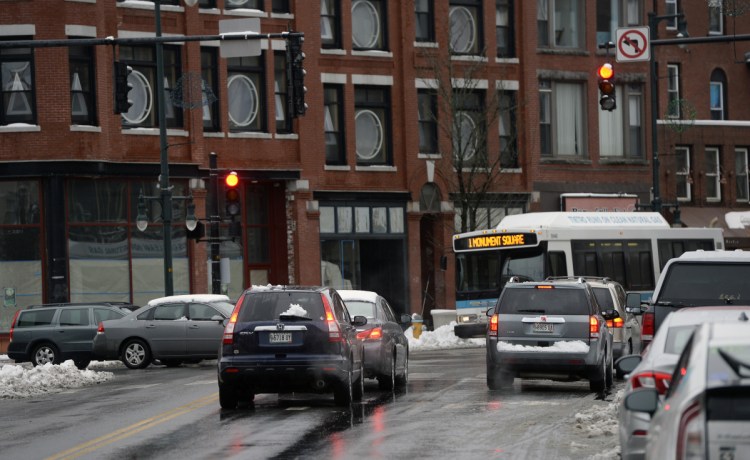It will cost at least $8 million a year for the next two decades to replace the state’s aging traffic signal network, an upgrade expected to save time, fuel and driver frustration.
Maintenance has lagged on many of the 801 state-owned traffic signals. Almost half have poles and supports that are in such poor condition they will have to be completely replaced in the near future, according to state estimates.
“Regardless of who owns or maintains traffic signals, the traveling public has come to expect a high standard for traffic signal operations. Unfortunately, that standard is not being met in many areas of the state,” a working group at the Maine Department of Transportation wrote in a report last month.
To solve the problem, the department is embarking on an expensive plan to replace every traffic signal with an advanced version that can be timed more efficiently, tell operators about malfunctions and talk to electronic and autonomous vehicles now beginning to appear on U.S. roads. It also plans to assume direct responsibility for signal upkeep statewide, an obligation now mostly held by cities and towns.

Most of Maine’s signals have traffic detectors, but when they fail due to poor upkeep, they revert to maximum wait times even on busy roads.
If the state is going to make the signal updates, they should be compatible with emerging technologies, such as self-driving cars, said state traffic engineer Steve Landry.
“This is about us trying to get the signals up to par,” Landry said. “As we’re doing it, we are getting new equipment that is going to be able to do more with technology in the future.”
Overall, Maine wants to get on a replacement schedule for a 20-year signal life cycle. That means shouldering the cost of a wholesale system replacement – about 40 signals a year at a cost of $200,000 per signal, roughly $160 million overall.
Next year, the department will replace 104 signals on thoroughfares in Sanford, Augusta, Waterville, Farmington and Belfast. About half of the $16.5 million project will be paid with a federal transportation grant.
But replacement won’t mean anything if signals aren’t maintained. The state currently takes care of only 51 traffic lights, or 6 percent of the total. The rest are left up to towns and cities that sometimes don’t have the budget, or expertise, to make sure the system is kept up.
When contractors like Ken Miller get called out, it’s typically to fix broken signal equipment, not to perform routine maintenance.
That means more signals malfunction, leading to more traffic congestion, wasted gas and lost time.
“The unfortunate thing is that everything has become reactive with traffic signals,” said Miller, president of Electric Light Co. in York.
“In the old days, there was scheduled maintenance; now there is no maintenance anymore,” he said. “You get told: ‘Fix this. It is all we appropriated for.’ ”
STATE CONTROL
Maine DOT plans to take direct control over signals or offer stipends to towns and cities that show the financial and technical ability to keep the signals working. Maintaining the system could cost $2 million a year.
“The proper maintenance and keeping things up and running is the biggest problem that we have,” Landry said. “If the equipment isn’t maintained properly, the signal isn’t going to work properly.”
The progression of Maine’s traffic signals – from red, to green, to yellow and back to red – is programmed based on average annual traffic counts collected and analyzed by the department. But if the signal’s traffic detection apparatus malfunctions, it will revert to the maximum wait time for each side of the intersection. That means a vehicle on a main thoroughfare will wait at the light just as long as one on a minor side street. Advanced traffic signals constantly collect traffic data to better allow signal timing and detection and warn when a signal isn’t working.
Better timing is likely to save time, money and make intersections safer. A coordinated four-signal corridor in Dover, New Hampshire, saved drivers more than $20,500 in annual fuel costs and reduced travel time by 46 percent, according to the November state report. Coordinating signals reduced crashes by nearly 9 percent in Portland and 52 percent in Waterville, according to a state analysis.
About 30 signals on busy travel corridors will be replaced by adaptive models that can monitor traffic and adjust light sequences based on congestion and demand, Landry said. Adaptive signals are already being used in Portland, where they have cut travel times in a heavily congested stretch of Forest Avenue.
The signal replacement project will have to compete with roads, bridges and safety projects in the department’s $324 million annual capital improvement budget. The state is already shoring up a $140 million highway budget shortfall with $80 million a year in borrowed money.
“It is not going to happen all at once,” Landry said. “We need to decide how we are going to take these things over, and where the money is going to come from to maintain them ourselves.”
Send questions/comments to the editors.




Comments are no longer available on this story